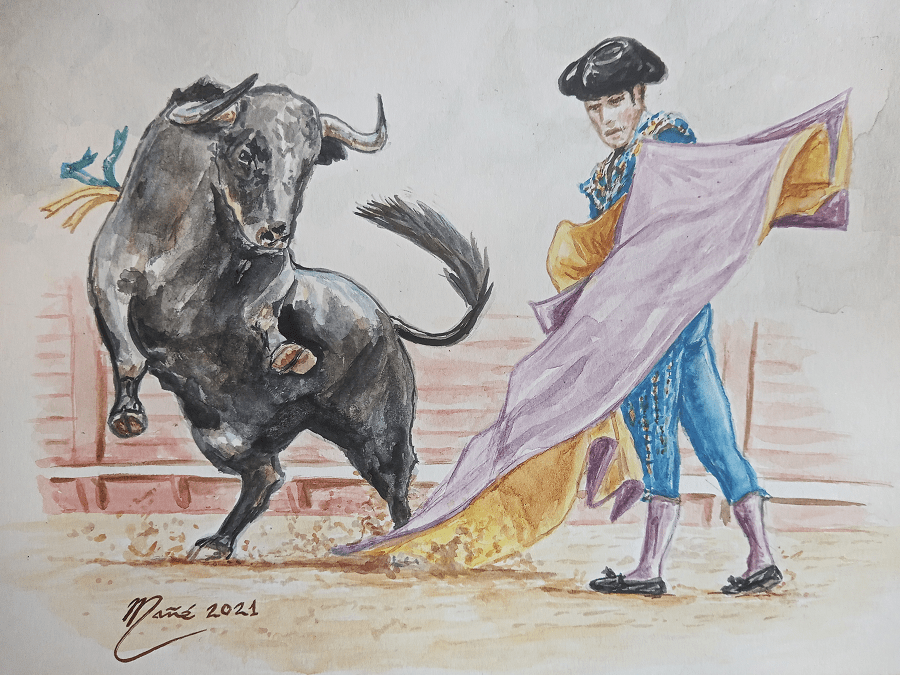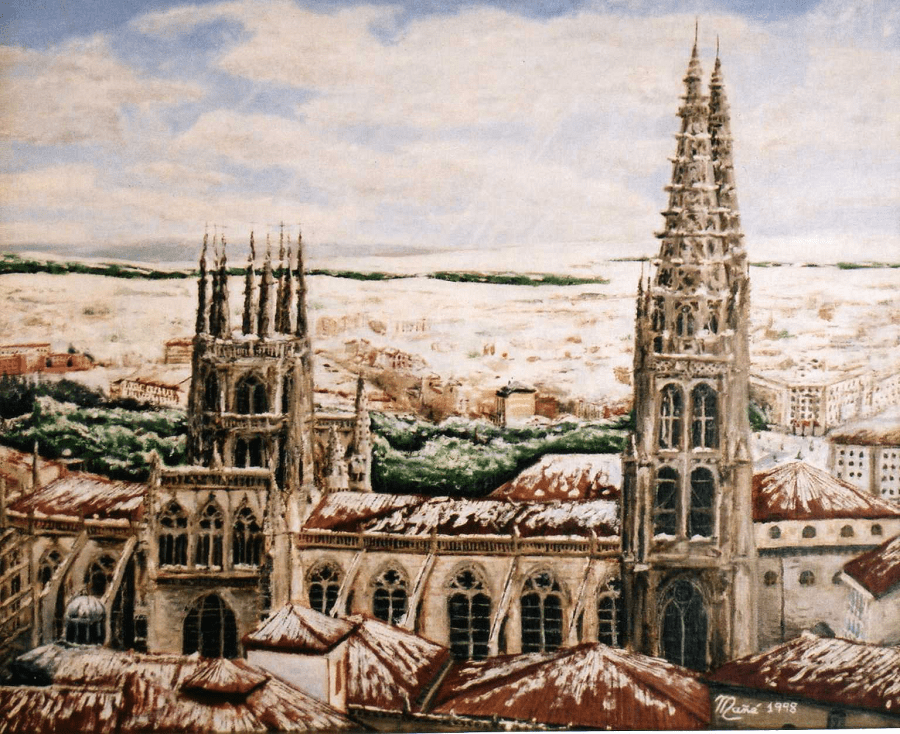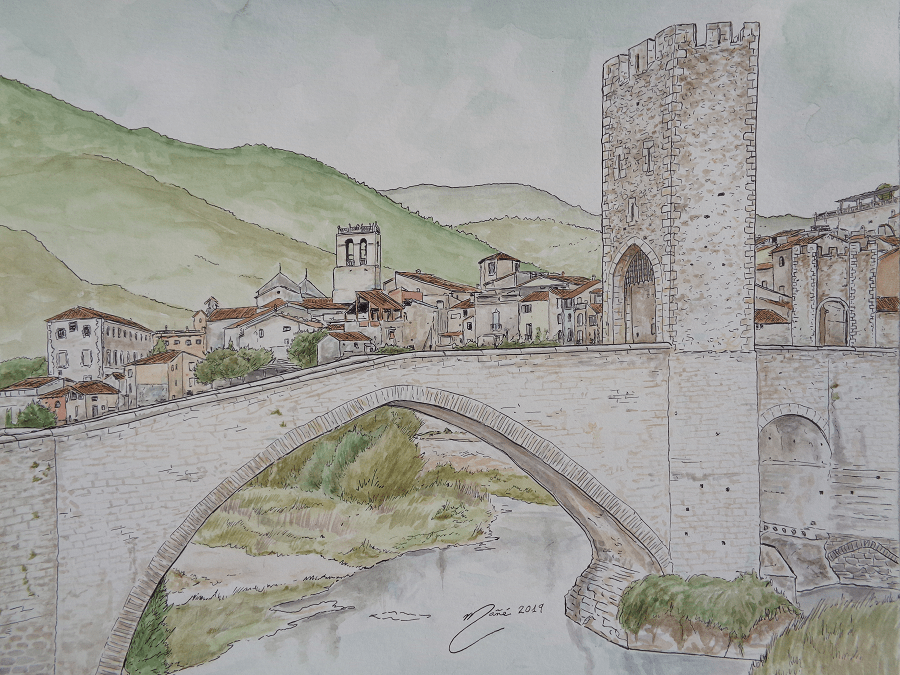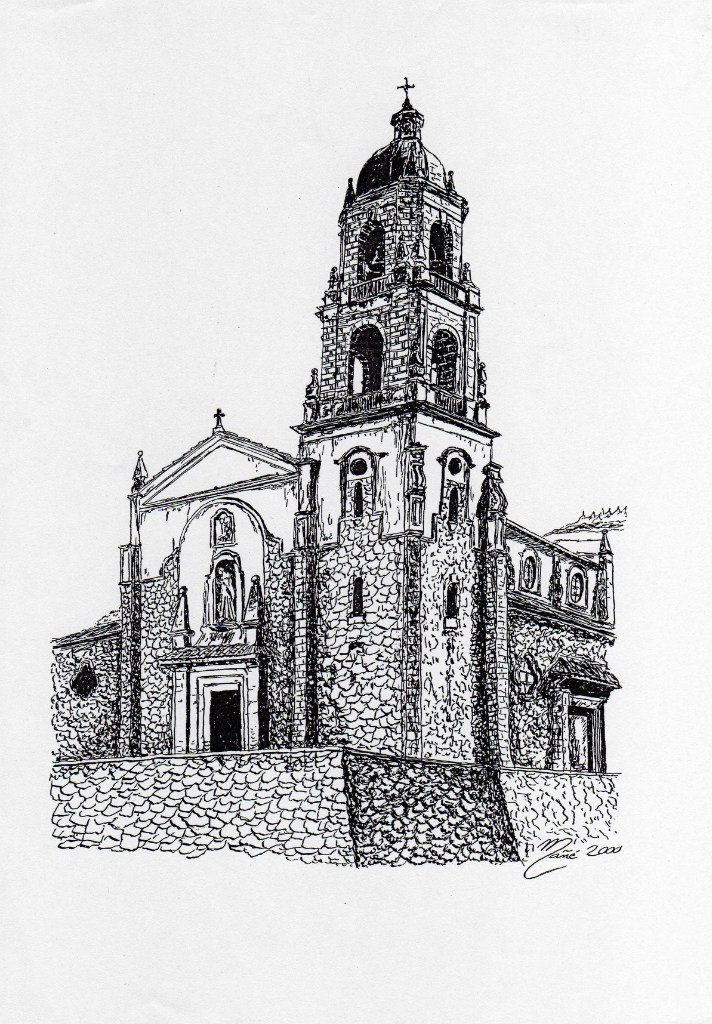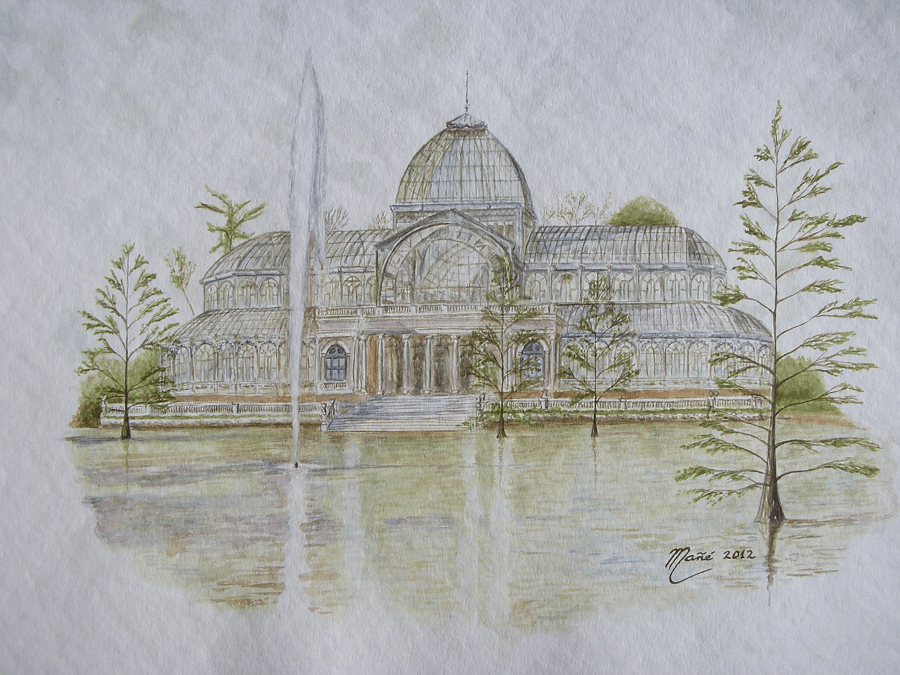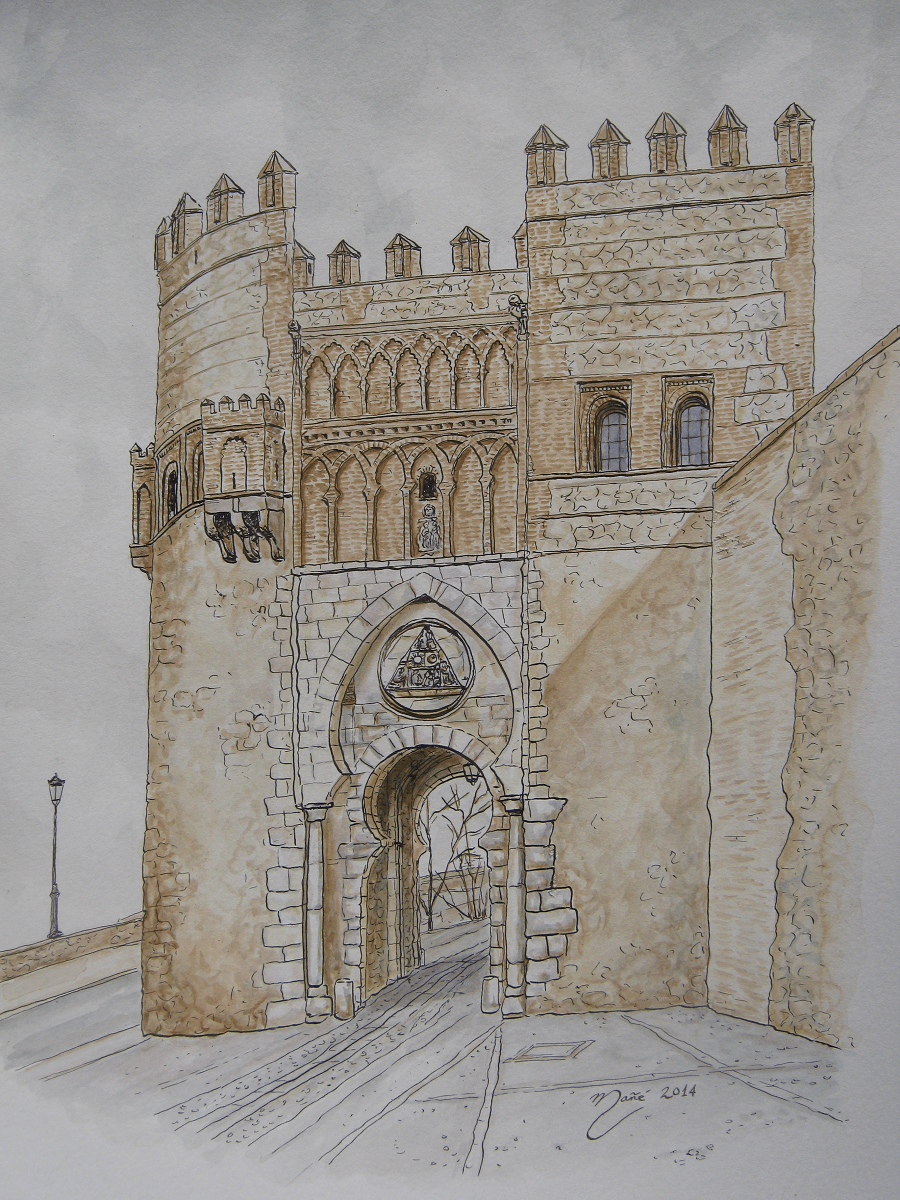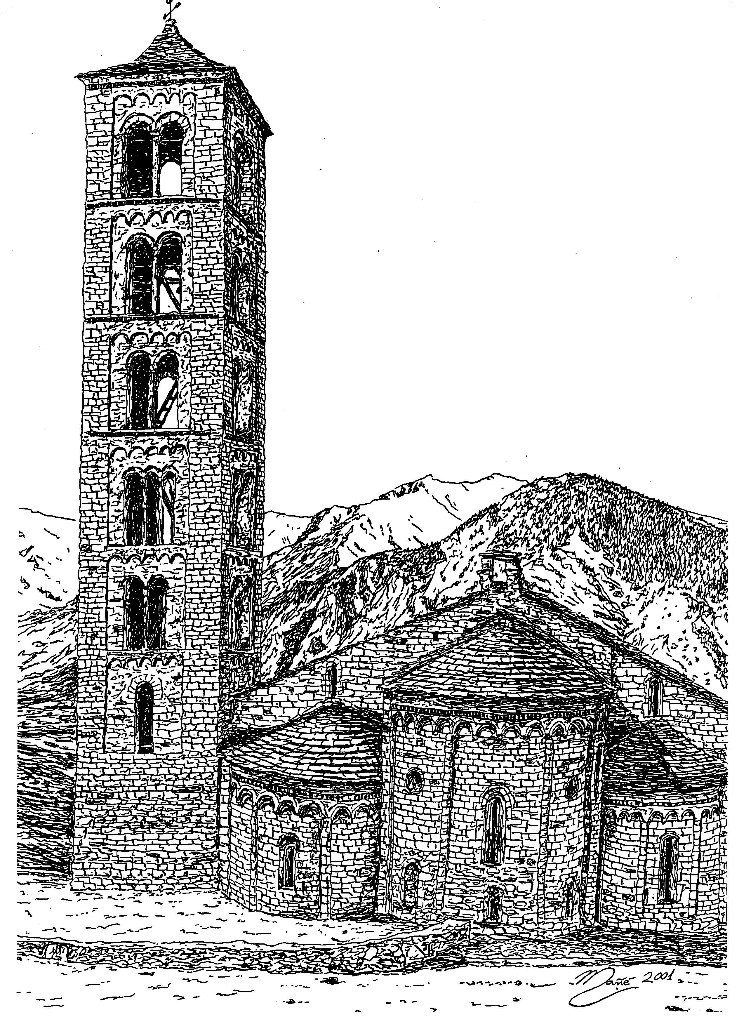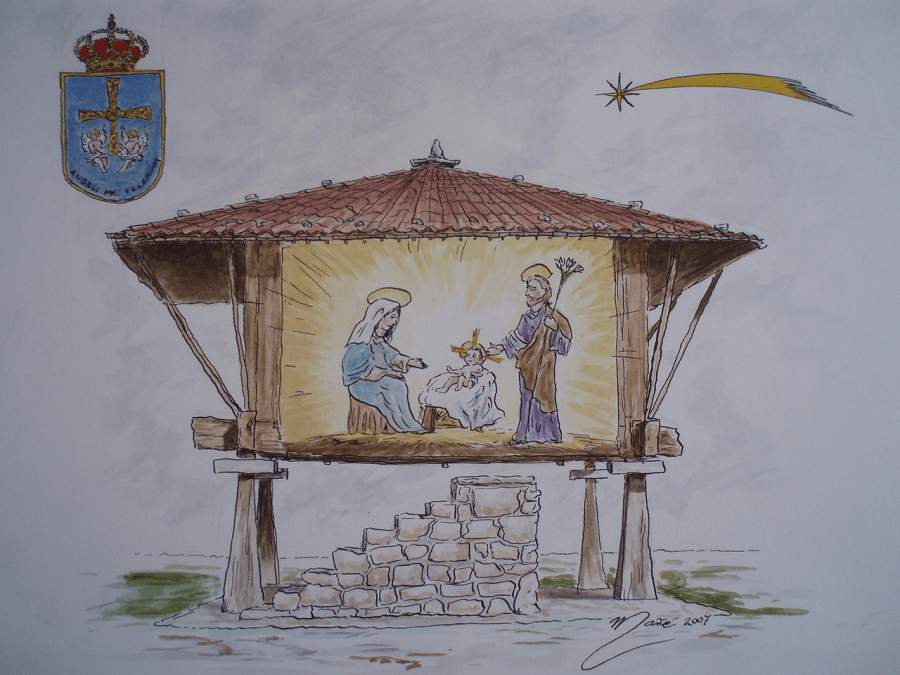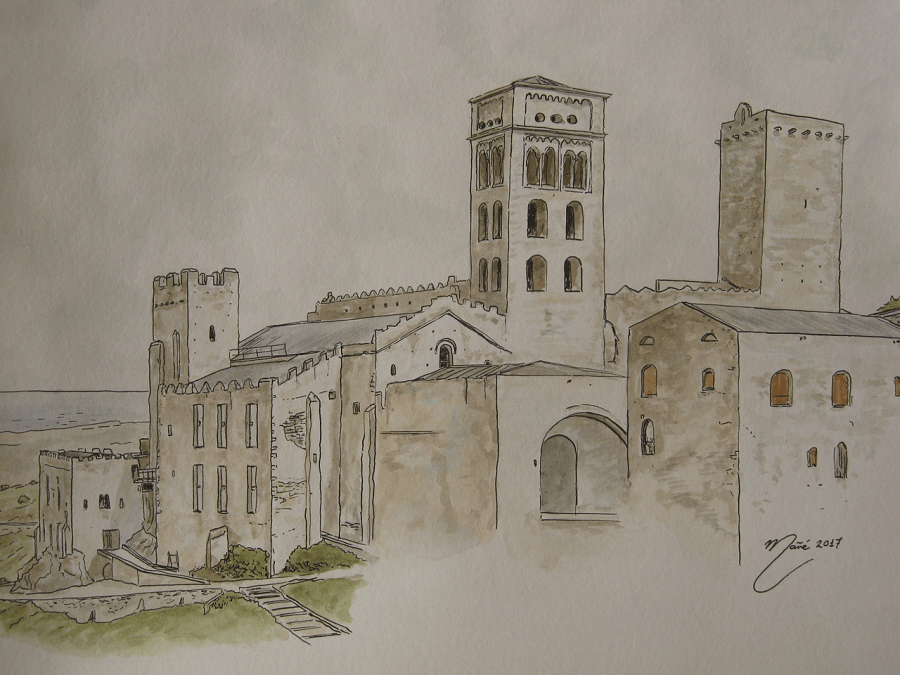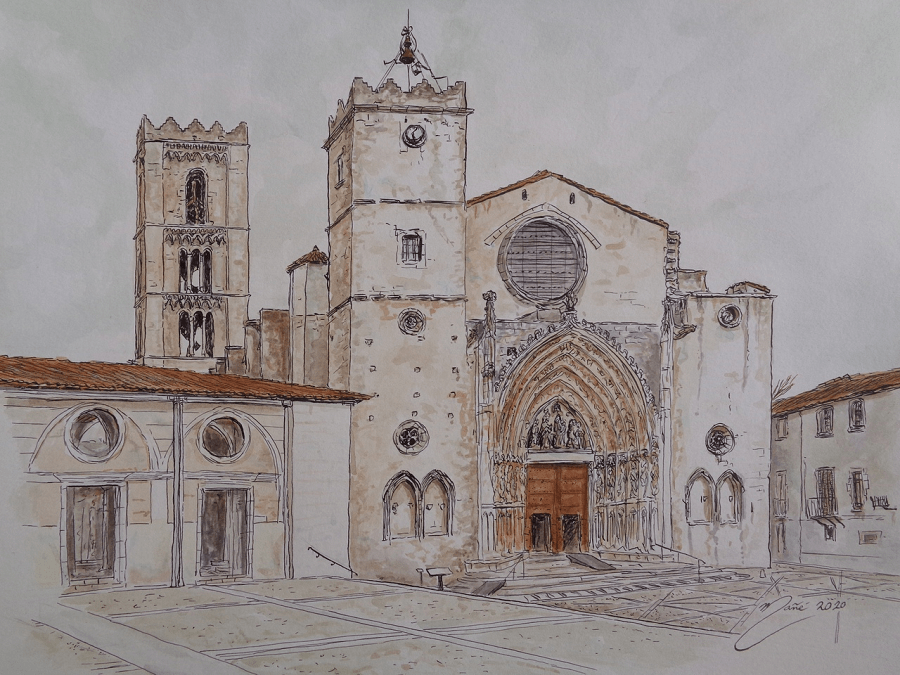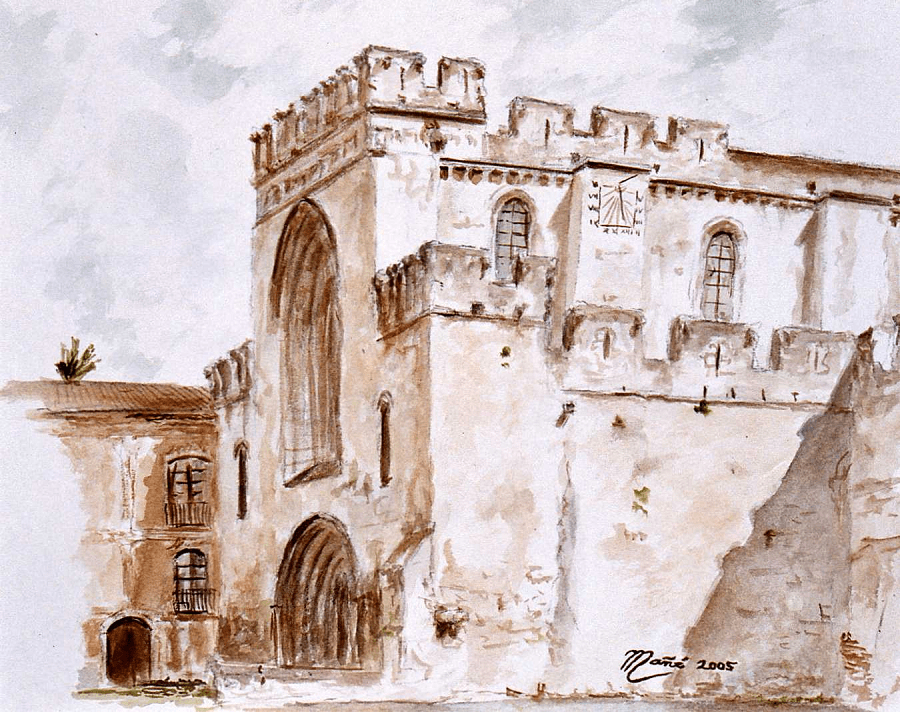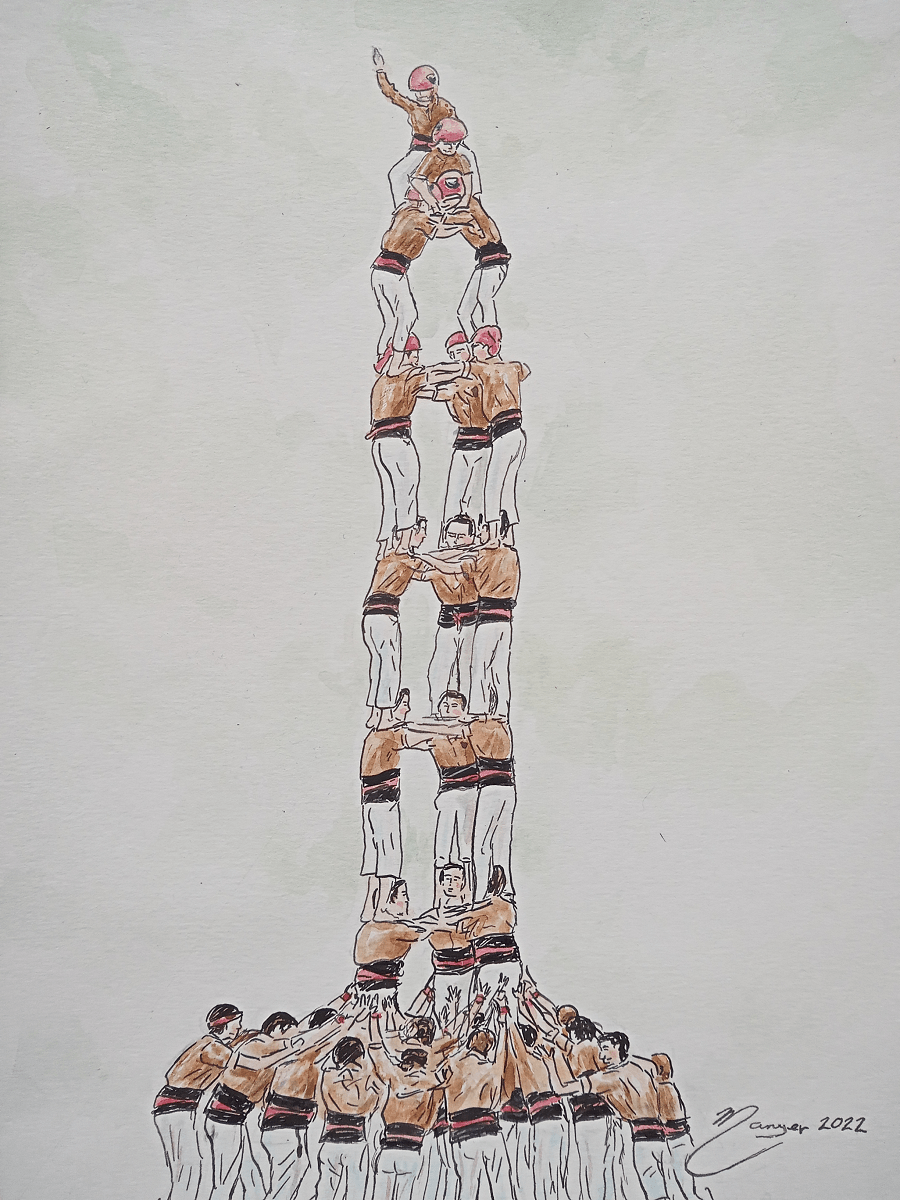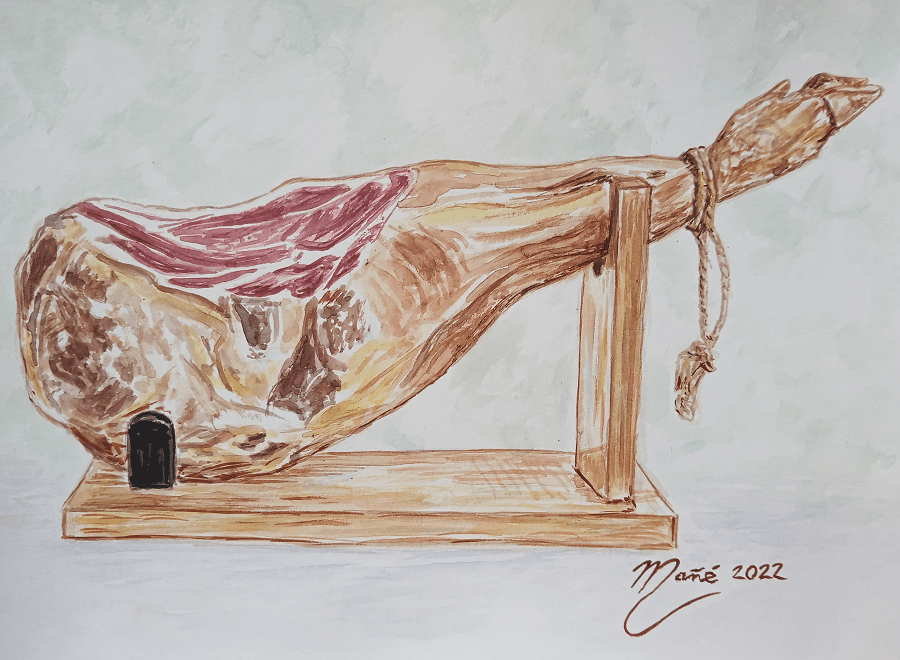Drawings by Joan Mañe
Spain, also known as the Kingdom of Spain, is a transcontinental sovereign country and a member of the European Union. It is constituted as a social and democratic state of law, whose form of government is the parliamentary monarchy. Its territory, with its capital in Madrid, is organized into seventeen autonomous communities, formed in turn by fifty provinces and two autonomous cities.
Spain is located both in the south of Western Europe and in the north of Africa. In Europe, it occupies most of the Iberian Peninsula, known as mainland Spain, and the Balearic Islands (in the western Mediterranean Sea). In Africa, there are the cities of Ceuta (in the Tingitana peninsula) and Melilla (in the cape of Tres Forcas), the Canary Islands (in the northeastern Atlantic Ocean) and other Mediterranean possessions called “squares of sovereignty.”
The municipality of Llivia, in the Pyrenees, constitutes an exclave completely surrounded by French territory. The set of territories is completed by a series of islands and islets off the peninsular coasts. It has an area of 505,370 km², making it the fourth largest country on the continent, after Russia, Ukraine and France, and with an average altitude of 650 meters above sea level, it is one of the most mountainous countries in Europe.
Its population exceeds 47 million inhabitants, although the population density is low. The peninsular territory shares land borders with France and Andorra to the north, with Portugal to the west and the British territory of Gibraltar to the south. In its African territories, it shares land and sea borders with Morocco. It shares with France sovereignty over the island of Pheasants at the mouth of the Bidasoa river and five Pyrenean facerías.
In accordance with the Constitution, and according to article 3.1, “Castilian is the official Spanish language of the State. All Spaniards have the duty to know it and the right to use it.” In 2020, it was the mother language of 82% of Spaniards. According to article 3.2, “the other Spanish languages will also be official in the respective Communities Autonomous in accordance with their Statutes.”
The Spanish or Castilian language, the second most spoken mother language in the world and with almost 600 million speakers, is one of the most important legacies of the cultural and historical heritage of Spain in the world.
Culturally belonging to Latin Europe and heir to a vast Greco-Roman influence, Spain is also home to the world’s fourth largest collection of UNESCO World Heritage Sites.
It belongs to the list of developed countries. It enjoys the 6th highest life expectancy in the world and a high income—its GDP places the Spanish economy in the fourteenth position in the world.
Thanks to its unique characteristics, Spain is a great tourist power and stands as the second most visited country in the world (after France)—more than 83 million tourists in 2019—and the second country in the world in economic income from international tourism. It has a very high human development index (0.904), according to the 2020 report of the UN Development Program.
The first confirmed presence of hominids of the Homo genus dates back to 1.2 million years before the present, as evidenced by the discovery of a still-unclassified Homo mandible at the Atapuerca site. In the 3rd century BC, the Roman intervention in the Peninsula took place, which led to a subsequent conquest of what would later become Hispania.
In the Middle Ages, the area was conquered by different Germanic peoples and by the Muslims, who had a presence for more than seven centuries. It is not until the fifteenth century, with the dynastic union of Castile and Aragon and the culmination of the Reconquest, together with the subsequent annexation of Navarre, when one can speak of the foundation of “Spain” as it was called abroad.
Already in the Modern Age, the Spanish monarchs dominated the first global overseas empire, which encompassed territories on five continents, leaving a vast cultural and linguistic heritage around the globe. At the beginning of the 19th century, after successive wars in Latin America, it lost most of its territories in America.
In the first third of the 20th century, a constitutional republic was proclaimed. A failed military coup d’état caused the outbreak of a civil war, the end of which the dictatorship of Francisco Franco began, which ended with his death in 1975. At this time, a transition to democracy began, the culmination of which was the ratification in a referendum and promulgation of the 1978 Constitution. Significantly increased during the so-called “Spanish economic miracle,” the economic and social development of the country has continued throughout the current democratic period.
Tourism
Spain is a tourist country with a developed infrastructure in the service sector, ranking among the three most visited in the world, which is attended by the fact that millions of travelers are attracted by its beaches and pleasant climate, the country’s abundant artistic heritage and gastronomic richness, as well as being one of the richest nations in terms of cultural heritage due to the large number of civilizations that left their mark on the Iberian peninsula.
Tourism in Spain is an economic activity that accounted for about 12.4% of the country’s GDP in recent years.
According to the report provided by Eurostat, Spain was the first country in the European Union in number of overnight stays, surpassing France, due to an increase of 4.3% compared to the previous year.
The tourism impact represents around 11% of the country’s gross domestic product, sustaining part of its economy in the service sector, with unparalleled development and excellence in hospitality and transportation since the tourism boom that occurred in the 1960s that was finally consolidated with the celebration in the fifth centenary of the Discovery of America (1492) of the Olympic Games of Barcelona and the Universal Exhibition of Seville.
With respect to income from the tourism sector, Spain is the second nation in the world, only surpassed by the United States according to the UNWTO. The main tourist destination is Catalonia, with Barcelona also being the main city receiving tourists, followed by the Canary Islands and the Balearic Islands.
In 2015, the World Economic Forum awarded Spain the first place in the world in tourism competitiveness. The World Tourism Organization has its headquarters in Madrid.
For several decades, special emphasis was placed on the promotion of sun and beach tourism, due to the much warmer and sunnier climate compared to other European countries. Summer temperatures often range between 20 and 40°C, and many regions have more than 300 days of sunshine a year, with summers generally being dry and hot.
The tourist capacity in the coastal towns provides a high number of hotels, restaurants and homes on the beach, of which the Costa del Sol and the Valencian coast are faithful exponents, with Marbella, Torremolinos and Benidorm as prominent promoters.
The north of Spain has a somewhat cooler and more humid climate. Many Spaniards and foreigners are attracted by the thousand-year-old Camino de Santiago or playful festivals, such as San Fermín in Pamplona. The northern zone combines rural tourism with large sandy areas that enjoy good weather in the summer and ski tourism in winter.
This area has a unique beauty due to the proximity of mountains with abundant vegetation and areas such as the Cantabrian coast, the Galician estuaries or the Picos de Europa.
Spanish gastronomy is wide and varied, with typical dishes such as gazpacho, paella, Madrid stew, bean stew, Iberian ham, seafood or the typical fish of the area. Olive oil, of which Spain is the leading producer in the world, is used in a wide variety of dishes, and is highly appreciated in other countries.
In recent years, interest in cultural tourism in Spain has grown, increasing the influx of visitors to destinations such as the Roman Mérida in Extremadura or historic places in Castile and León.
PLACES TO VISIT. 17 COMMUNITIES (IN ALPHABETICAL ORDER, 710 OBJECTS)
Andalusia
Andalusia is the southernmost autonomous community in Spain. It is the most populous and the second largest autonomous community in the country. Its capital city is Seville.
The territory is divided into eight provinces: Almería (capital Almería), Cádiz (capital Cádiz), Córdoba (capital Córdoba), Granada (capital Granada), Huelva (capital Huelva), Jaén (capital Jaén), Málaga (capital Málaga), and Seville (capital Seville). The seat of the High Court of Justice of Andalusia is located in the city of Granada.
Borders with Extremadura and Castilla–La Mancha in the north, and with Region of Murcia in the west.
With almost 30 million annual visitors whose main destinations within the community are the Costa del Sol, Costa de la Luz and Sierra Nevada, Andalusia is the fourth autonomous community by number of visitors from all sources, after Catalonia, the Balearic Islands and the Canary Islands. The highest tourist demand is concentrated in the summer period.
Full guide is here (87 objects)
Aragon
Aragon is an autonomous community in northeastern Spain. Its capital is Zaragoza. Consists of three provinces: Huesca (capital Huesca), Zaragoza (capital Zaragoza), and Teruel (capital Teruel). The current Statute of Autonomy declares Aragon a historic nationality of Spain.
It limits to the north with France (Occitania and Nueva Aquitania), to the west with Castilla-La Mancha, Castile and León, La Rioja, Navarre and to the east with Catalonia and the Valencian Community.
Mudéjar architecture of Aragon is an aesthetic trend in Mudéjar that has been recognized in some representative buildings as a World Heritage Site by UNESCO.
Full guide is here (55 objects)
Asturias
Asturias, officially the Principality of Asturias, is an autonomous community in northwest Spain. Oviedo is, according to the Statute of Autonomy, is the capital and a seat of the institutions of the Principality of Asturias. The most populated city in the community is Gijón. Consists of one province of Asturias.
Bordered by Cantabria to the east, by Castile and León to the south, by Galicia to the west, and by the Cantabrian sea to the north.
First of all, the region is known for its sea resorts. Costa Verde (Green Coast) is the tourist name assigned to the coast of Asturias, located in the Cantabrian Sea, Atlantic Ocean. It includes the coast of the maritime province of Gijón created in 1845, and maritime province of Avilés, created in 2007.
Full guide is here (20 objects)
Basque Autonomous Community
Basque Autonomous Community is an autonomous community in northern Spain. Its basic institutions are the Basque Parliament and the Basque Government, based in the de facto capital city of Vitoria-Gasteiz. It includes the Basque provinces of Álava (capital Vitoria-Gasteiz), Biscay (capital Bilbao), and Gipuzkoa (capital San Sebastian).
It limits to the east with Navarre and the French department of Pirineos Atlánticos (region of Nueva Aquitania), to the south with La Rioja and to the west with Castile and León and Cantabria.
The Basque Country has a wide range of active tourism companies and all kinds of adventure sports, from the most technical and specialized to the most common modalities such as surfing, mountain biking, hiking and bird watching.
Among the resorts of Costa Vasca, the royal San Sebastian stands out.
Full guide is here (38 objects)
Canary Islands
Canary Islands, also known informally as the Canaries, are a Spanish region and archipelago in the Atlantic Ocean, in Macaronesia. They are the southernmost of the autonomous communities of Spain
At their closest point to the African mainland, they are 100 kilometres west of Morocco. The archipelago is economically and politically European and is part of the European Union.
Cantabria
Cantabria is an autonomous community in Spain, defined as a historical community in its Statute of Autonomy. The city of Santander is its capital. Consists of one province of Cantabria.
It limits to the east with the Basque Autonomous Community, to the south with Castile and León, to the west with the Principality of Asturias and to the north with the Cantabrian Sea.
Cantabria has archaeological sites from the Upper Paleolithic period, although the first signs of human occupation date from the Lower Paleolithic. The most significant site for cave paintings is that in the cave of Altamira in Santillana del Mar, dating from about 37,000 BC and declared, along with nine other Cantabrian caves in Puente Viesgo, as World Heritage Sites by UNESCO.
Among the resorts of Costa Cantabria, Castro Urdiales, Laredo and the royal resort of Comillas stand out.
Full guide is here (20 objects)
Castile and León
Castile and León is an autonomous community of Spain, referred to as a “historical and cultural community” in its Statute of Autonomy. It is the largest autonomous community in Spain in terms of area. The capital city is Valladolid.
It is made up of nine provinces: Ávila (capital Ávila), Burgos (capital Burgos), León (capital León), Palencia (capital Palencia), Salamanca (capital Salamanca), Segovia (capital Segovia), Soria (capital Soria), Valladolid (capital Valladolid) and Zamora (capital Zamora).
Castile and León is a landlocked region, bordered by Portugal as well as by the Spanish autonomous communities of Galicia, Asturias, Cantabria, Basque Community, La Rioja, Aragon, Castile-La Mancha, the Community of Madrid and Extremadura.
The heritage of Castile and León includes: 9 World Heritage Sites, almost 1,800 classified assets of cultural interest, 112 historical sites, 400 museums, more than 500 castles, of which 16 are considered to be of high historical value, 12 cathedrals, 1 co-cathedral, and the largest concentration of Romanesque art in the world.
Full guide is here (76 objects)
Castilla–La Mancha
Castilla–La Mancha, or Castile-La Mancha, is an autonomous community of Spain. The capital city is Toledo. Comprising the provinces of Albacete (capital Albacete), Ciudad Real (capital Ciudad Real), Cuenca (capital Cuenca), Guadalajara (capital Guadalajara) and Toledo (capital Toledo), it was created in 1982.
It is bordered by Castile and León, Community of Madrid, Aragon, Valencian community, Murcia community, Andalusia community, and Extremadura community.
The symbol of the region is the typical design of windmills, which have spread around the world thanks to the work of Miguel de Cervantes (“Don Quixote Route“).
Full guide is here (63 objects)
Catalonia
Catalonia (cat. Catalunya, Aran. Catalonha, Sp. Cataluña) is an autonomous community of Spain. The capital city is Barcelona.
It is located on the northeastern coast of the Iberian Peninsula and borders Andorra and France in the north, Aragon in the west, Valencian community in the south and the Mediterranean Sea in the east.
Consists of four provinces: Barcelona (capital Barcelona), Girona (capital Girona), Lleida (capital Lleida), Tarragona (capital Tarragona).
Catalonia is the largest part of the historical and cultural territory of the Principality of Catalonia and one of the countries belonging to the Catalan countries.
Tourism in Catalonia is one of the most important sectors of the Catalan economy. It is the main tourist destination in Spain and one of the most important in Europe. One of the main destinations is the metropolitan area of Barcelona.
Catalonia is one of the leading tourist regions in the world. Tourism accounts for about 11-12% of Catalonia’s GDP.
In addition to the huge architectural heritage of Catalonia, the largest part of the so-called Costas belongs to the Mediterranean resorts of Spain (from north to south): Costa Brava, Costa del Maresme, Costa de Barcelona, Costa del Garraf, Costa Daurada.
Full guide is here (139 objects)
Community of Madrid
Community of Madrid is an autonomous community of Spain. It is located in the centre of the Iberian Peninsula, and of the Central Plateau (Meseta Central). Its capital is the city of Madrid, which is also the capital of the country.
The Community of Madrid is bounded to the south and east by Castilla–La Mancha and to the north and west by Castile and León. It was formally created in 1983, based on the limits of the province of Madrid, which was until then conventionally included in the historical region of New Castile.
The region contains three World Heritage Sites: the Monastery and Royal Site of El Escorial, the University and historic centre of Alcalá de Henares, and the cultural landscape of Aranjuez.
Full guide is here (10 objects)
Extremadura
Extremadura is an autonomous community of Spain. Its capital city is Mérida. Located in the central-western part of the Iberian Peninsula, it is crossed from east to west by the Tagus and Guadiana rivers. The autonomous community is formed by the two largest provinces of Spain: Cáceres and Badajoz.
Extremadura is bordered by Portugal to the west and by the autonomous communities of Castile and León (north), Castilla–La Mancha (east) and Andalusia (south).
Extremadura has three places that have been declared a Cultural World Heritage Site by UNESCO:
Old City of Cáceres, since 1986.
Archaeological site of Mérida, since December 1993.
Royal Monastery of Our Lady of Guadalupe, since 1993.
Full guide is here (30 objects)
Galicia
Galicia is an autonomous community of Spain. The capital is Santiago de Compostela.
Located in the northwest Iberian Peninsula, it includes the provinces of A Coruña (capital A Coruña), Lugo (capital Lugo), Ourense (capital Ourense) and Pontevedra (capital Pontevedra).
It is bordered by Portugal to the south, the Spanish autonomous communities of Castile and León and Asturias to the east, the Atlantic Ocean to the west, and the Cantabrian Sea to the north.
The ancient city of Santiago has been a UNESCO World Heritage Site since 1985. It stands out for being one of the three great pilgrimage centers of Christianity, along with Jerusalem and Rome, by pointing out the tradition that the Saint James the Greater was buried there. It is the final stop of the Way of St. James pilgrimage route.
The Atlantic resorts of Galicia include the regions of Rias Altas, Costa da Morte, Rias Baixas.
Full guide is here (71 objects)
La Rioja
La Rioja is an autonomous community and province in Spain, in the north of the Iberian Peninsula. Its capital is Logroño.
It covers part of the Ebro valley towards its north and the Iberian Range in the south.
The community is a single province, so there is no County Council, and it is organized into 174 municipalities. It borders the Basque community to the north, Navarre to the northeast, Aragón to the southeast, and Castile and León to the west and south.
Full guide is here (15 objects)
Navarre
Navarre (Spanish: Navarra), officially the Chartered Community of Navarre, is a foral autonomous community and province in northern Spain. The capital city is Pamplona (Basque: Iruña).
Borders the Basque Community, La Rioja, and Aragon in Spain and Nouvelle-Aquitaine in France.
Full guide is here (23 objects)
Region of Murcia
Region of Murcia is an autonomous community of Spain located in the southeast part of the Iberian Peninsula, on the Mediterranean coast. Its capital city is Murcia.
The region is centered on a historical region of the same name in what is now southeastern Spain. It is heir to the ancient Kingdom of Murcia, which traditionally included, as a bi-provincial region, the provinces of Albacete and Murcia. Today the region is subdivided into municipalities. Borders Valencian Community in the north, Castilla–La Mancha in the east and Andalusia in the south.
Notable features of the region’s extensive cultural heritage include 72 cave art ensembles, which are part of the rock art of the Iberian Mediterranean Basin, a World Heritage Site. Other culturally significant features include the Council of Wise Men of the plain of Murcia and the tamboradas (drumming processions) of Moratalla and Mula, which were declared intangible cultural heritage by UNESCO. The region is also the home of Caravaca de la Cruz, a holy city in the Catholic Church that celebrates the Perpetual Jubilee every seven years in the Santuario de la Vera Cruz.
Among the seaside resorts of the region (Costa Calida), Cartagena, Mazarron, La Manga del Mar Menor stand out. The northern end of this coast includes Mar Menor, a coastal salt water lagoon which, with an area of approximately 170 km², is the largest in Europe.
Full guide is here (19 objects)
Valencian Community
Valencian Community is an autonomous community of Spain. Its homonymous capital Valencia is the third largest city and metropolitan area in Spain. The Valencian Community consists of three provinces which are Castellón (capital Castellón de la Plana), Valencia (capital Valencia) and Alicante (capital Alicante).
It is located along the Mediterranean coast on the east side of the Iberian peninsula. It borders with Catalonia to the north, Aragon and Castilla–La Mancha to the west, and Murcia to the south.
The Mediterranean coast of the Valencian Community is divided into the following resort regions (from north to south): Costa del Azahar, Costa de Valencia, Costa Blanca.
Full guide is here (43 objects)
Seaside resorts
The most popular Spanish mainland coasts are on its Mediterranean and Atlantic sides, and include, from north to south:
Most Beautiful villages of Spain
The Most Beautiful Towns of Spain (Es. Los Pueblos Más Bonitos de España) is a Spanish association created in 2011 to promote, disseminate, encourage and preserve the cultural, natural and rural heritage in geographical areas with a lower level of industrialization and population.
It is a tool for cultural dissemination based on the French model of Les Plus Beaux Villages de France and spread internationally since 1982. Its objective is, according to its statutes:
The association has the following purposes: to promote, disseminate and preserve the cultural, natural and rural heritage, awareness and education towards respecting the values of rural heritage, promotion of cultural tourism, promotion of geographical areas with a lower level of industrialization, reduction of territorial and population imbalances, with respect for the cultural diversity of the different nationalities and their corresponding languages.
Best cultural routes. TOP 3
The Camino de Santiago, known in English as the Way of St. James, is a network of pilgrims’ ways or pilgrimages leading to the shrine of the apostle Saint James the Great in the cathedral of Santiago de Compostela in Galicia in northwestern Spain, where tradition holds that the remains of the apostle are buried.
The Camino del Cid is a cultural tourist itinerary and an approved Long Distance Trail (GR-160) based on a historical character, Rodrigo Díaz, and a literary work: El Cantar de mí Cid. In both cases they are international references: El Cid, “Castilian hero par excellence, the most exalted knight of medieval Spain” and El Cantar, “one of the great classic works of European literature”.
The Don Quixote Route refers to the journey that the protagonist of the novel El ingenioso hidalgo Don Quijote de la Mancha by Miguel de Cervantes followed in his adventures through the lands of La Mancha, mainly, as well as Aragon and Catalonia.
Winter ski resorts
The main skiing parts of Spain are located in the Pyrenees, the Cantabrian, Iberian and the Central mountains and the Penibetico mountain range in the south.
The Aragonese and Catalan Pyrenees in northern Spain are home to most of the countries leading ski resorts although the Sierra Nevada located in Andalucia in southern Spain ranks amongst the best and the most visited.
There is also an offer of ski resorts near Madrid, Galicia, Leon and Cantabria in the northwest and La Rioja and Teruel in the mid-north.
Main information
Area: 505 944 sq. km
Borders: 1952.7 km
Coastline: 4964 km
GPS coordinates: 40°25′08″N 3°41′31″W
Population: 47 450 795
Language: Spanish, Catalan, Basque, Galician
Currency: Euro
Visa: Schengen
ISO: 724 / ESP / ESl code
Internet domain: .es
Phone prefix: +34
Time: Central European UTC +1, in summer +2
____________________
All Pyrenees: The All Pyrenees travel guide through Spain includes more than 400 cities and villages, 500 castles, monasteries and other historic and architectural objects, natural heritage sites, museums, routes, seaside resorts, ski stations and many more. The guide is illustrated with more than 6000 photos.
Photographers: Alex Monroe, Phillipe Granders, Douglas Tribbers, Irina Rybalchenko, Valery Mostakov
Authors: Jose Fernandes, Jorge Garcia, Ion Lopez, Andrew Morato, Jane Cautch, Mathew Kristes, Irina Rybalchenko
Copyright © 2022 All Pyrenees. All rights reserved. You may not copy, reproduce, distribute, publish, display any type of information or photos without written permission.



